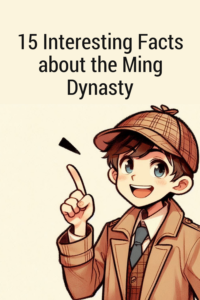The Qing Dynasty, which ruled China for over two centuries, is a fascinating chapter in Chinese history. From its intriguing emperors to its distinct culture and legacy, this dynasty has left a lasting impact on the world. In this article, we will delve into 15 captivating facts about the Qing Dynasty that will both surprise and enlighten you.
Introduction
The Qing Dynasty, also known as the Manchu Dynasty, was the last imperial dynasty of China, reigning from 1644 to 1912. Established by the Manchu people, this dynasty witnessed a series of remarkable events and developments that are still relevant today. Let’s explore these remarkable facts in detail.
Fact 1: The Rise of the Manchus
The Forbidden City’s Design Inspired by Heaven: The Forbidden City in Beijing, a UNESCO World Heritage Site, was meticulously designed in accordance with ancient Chinese cosmology, with the belief that it was a divine reflection of heaven on Earth. Every aspect of its architecture was constructed to represent the harmony between heaven and the emperor’s rule.
A Staunchly Confucian Dynasty: The Qing Dynasty adhered to Confucianism, a philosophy that heavily influenced Chinese society. Confucian principles of hierarchy, family, and respect for tradition were deeply ingrained in the dynasty’s policies and culture.
A Multicultural Empire: The Qing Dynasty was incredibly diverse, comprising various ethnic groups, including Manchus, Han Chinese, Mongols, Tibetans, and Uighurs. This multicultural empire was characterized by its ability to unite and rule over such a vast and varied population.
Fact 2: Kangxi, the Longest-Reigning Emperor
Kangxi’s Unprecedented Reign: Kangxi, the fourth emperor of the Qing Dynasty, holds the record for the longest-reigning emperor in Chinese history. He ascended to the throne at just seven years old and ruled for a remarkable 61 years, from 1661 to 1722.
Kangxi’s Remarkable Scholarly Pursuits: In addition to his political leadership, Kangxi was a highly educated and accomplished scholar. He assembled a team of scholars to create the Kangxi Dictionary, an enormous and comprehensive Chinese dictionary that is still widely used today.
The “Age of Kangxi and Qianlong”: Kangxi’s reign, along with that of his grandson Qianlong, is often referred to as the “Age of Kangxi and Qianlong.” These two emperors presided over a period of stability and prosperity in Qing China.
Fact 3: The Queue Order
Mandatory Manchu Hairstyle: The Queue Order, introduced by the Qing Dynasty, mandated that all Han Chinese men must wear their hair in the “queue” style, with a shaved forehead and a long pigtail at the back. This order was intended to distinguish Han Chinese from Manchu people.
Resistance and Rebellion: The Queue Order was met with resistance and even rebellion in some areas of China. Many Chinese resented the hairstyle as a symbol of foreign oppression and viewed it as an affront to their culture and identity.
The Decline of the Queue: After the fall of the Qing Dynasty, the queue hairstyle gradually fell out of fashion, and today, it is no longer a common sight in China.
Fact 4: The Opium Wars
The Opium Wars and Treaty of Nanking: The Opium Wars, fought between China and Great Britain in the mid-19th century, were a significant turning point in Qing history. The Treaty of Nanking in 1842 marked the end of the First Opium War and resulted in the cession of Hong Kong to the British.
Impact of the Opium Trade: The Opium Wars were fueled by the British trade of opium in China, which had devastating effects on Chinese society, causing widespread addiction and social upheaval.
Historical Significance: These wars marked the decline of the Qing Dynasty and the beginning of increased Western influence in China, leading to a series of further conflicts and changes in the country’s governance.
Fact 5: The Taiping Rebellion
The Taiping Rebellion and Hong Xiuquan: The Taiping Rebellion, one of the bloodiest conflicts in history, was led by Hong Xiuquan, who believed he was the younger brother of Jesus Christ. His followers, known as the Taiping Heavenly Kingdom, aimed to overthrow the Qing Dynasty and establish a utopian Christian society.
Unprecedented Casualties: The Taiping Rebellion resulted in an estimated 20 million deaths, making it one of the deadliest conflicts in history.
Legacy of Reform: While the Taiping Rebellion ultimately failed, it had a lasting impact on China. Some of the reforms and ideas promoted by the Taiping Heavenly Kingdom influenced future political and social movements in China.
Fact 6: The Last Empress Dowager
Empress Dowager Cixi’s Remarkable Reign: Empress Dowager Cixi was a formidable figure in Qing history. She effectively ruled as a regent for much of her life, making crucial decisions and overseeing the dynasty’s affairs. Her rule extended through the end of the 19th century and into the 20th century.
The Boxer Rebellion: Empress Dowager Cixi played a role in supporting the Boxer Rebellion, an anti-foreign and anti-Christian movement. The rebellion culminated in the siege of foreign embassies in Beijing.
Modernization and Reforms: Despite her conservative stance, Cixi initiated some modernization efforts, such as the construction of railroads and telegraph lines.
Fact 7: The Fall of the Qing Dynasty
The Xinhai Revolution: The Qing Dynasty met its end in 1912 with the Xinhai Revolution, which led to the abdication of the last Qing emperor, Puyi. This marked the end of over two millennia of imperial rule in China.
The Republic of China: Following the revolution, the Republic of China was established, and Sun Yat-sen became its first provisional president. The imperial system was officially abolished, bringing an end to the Qing Dynasty.
The Last Emperor: Puyi, the last Qing emperor, was allowed to live in the Forbidden City for a few more years before being expelled. His life story was later depicted in the movie “The Last Emperor.”
Fact 8: The Legacy of the Qing Dynasty
Influence on Chinese Culture: The Qing Dynasty left an enduring mark on Chinese culture, including art, fashion, and cuisine. Qing-style clothing, known for its elaborate embroidery and distinctive designs, continues to influence fashion trends in modern China.
Chinese Opera and Literature: The Qing Dynasty played a significant role in the development of Chinese opera and literature. Peking opera, one of the most famous Chinese opera styles, emerged during this period.
The Great Wall: The Qing Dynasty was responsible for the maintenance and restoration of the Great Wall of China. Their efforts helped preserve this iconic symbol of China.
Fact 9: The Forbidden City Today
A Popular Tourist Attraction: Today, the Forbidden City is one of the most visited tourist attractions in the world. It provides visitors with a glimpse into the opulent life of the emperors and the grandeur of Chinese imperial architecture.
The Palace Museum: The Forbidden City now houses the Palace Museum, which contains an extensive collection of Chinese art and historical artifacts. This museum offers an unparalleled opportunity to explore China’s rich history.
UNESCO World Heritage Site: In 1987, the Forbidden City was designated as a UNESCO World Heritage Site, recognizing its cultural significance and architectural marvel.
Fact 10: Chinese New Year Traditions
Qing Dynasty Origins of Chinese New Year: Many of the customs associated with Chinese New Year, such as the use of red decorations, the giving of red envelopes (hongbao), and the dragon and lion dances, have their origins in the Qing Dynasty.
Symbolism of Red: The color red was believed to ward off evil spirits and bring good luck. Red lanterns, clothing, and decorations continue to be a significant part of Chinese New Year celebrations.
Firecrackers and Fireworks: The tradition of lighting firecrackers and fireworks during Chinese New Year was meant to scare away evil spirits. It is a practice that continues to this day.
Fact 11: The Influence of the Qing Dynasty on Taiwan
Qing Rule Over Taiwan: The Qing Dynasty’s control over Taiwan lasted from 1683 to 1895, when it ceded the island to Japan after losing the First Sino-Japanese War.
Taiwan’s Cultural Legacy: Despite its relatively short period of rule, the Qing Dynasty’s influence is still evident in Taiwan’s culture, language, and cuisine.
Taiwan’s Complicated History: Taiwan’s history, with its multiple periods of colonization and rule, is a testament to its rich and diverse heritage.
Fact 12: The Yongzheng Emperor’s Mystery
Secret Under the Emperor’s Throne: The Yongzheng Emperor, known for his efficient governance, was said to have hidden a secret message beneath his throne. This mystery has captivated historians and treasure hunters for centuries.
The Unsolved Enigma: To this day, the exact nature of the message and whether it even exists remains a mystery. Some believe it could contain crucial state secrets or personal reflections.
A Source of Intrigue: The legend of the secret message has added an air of intrigue to the already fascinating history of the Qing Dynasty.
Fact 13: The Qing Dynasty’s Lunar Calendar
The Qing Dynasty’s Lunar Calendar: The Qing Dynasty used the traditional Chinese lunar calendar for official purposes. This calendar was essential for scheduling important events and agricultural activities.
Lunar Calendar Festivals: Many of China’s traditional festivals, such as the Mid-Autumn Festival and the Dragon Boat Festival, are based on the lunar calendar. These festivals continue to be celebrated with great enthusiasm.
The Significance of the Lunar Calendar: The lunar calendar reflects the close connection between Chinese culture and the cycles of the moon and agriculture.
Fact 14: The Kangxi Emperor’s Religious Tolerance
Promoting Religious Harmony: Kangxi Emperor was notable for his religious tolerance, particularly toward Christianity. He welcomed Christian missionaries to his court and was open to learning about Western science and culture.
The Jesuit Missionaries: The Jesuit missionaries, including Matteo Ricci and Adam Schall von Bell, played a pivotal role in introducing Western knowledge to China during Kangxi’s reign.
An Era of Cultural Exchange: Kangxi’s embrace of different cultures and ideas fostered a period of cultural exchange between China and the West.
Fact 15: Qing Dynasty’s Contributions to Medicine
Innovations in Traditional Chinese Medicine: The Qing Dynasty witnessed significant advancements in traditional Chinese medicine. Prominent physicians and scholars made breakthroughs in herbal medicine and acupuncture.
The Compendium of Materia Medica: One of the most renowned works of this era is the “Compendium of Materia Medica” by Li Shizhen, which remains a vital reference in Chinese medicine.
Ancient Wisdom in Modern Healthcare: Traditional Chinese medicine, rooted in the Qing Dynasty’s contributions, continues to be widely practiced and integrated into modern healthcare in China and around the world.
Conclusion
The Qing Dynasty’s history is a rich tapestry of intriguing events, remarkable rulers, and enduring legacies. From its impressive reign to its lasting impact on Chinese culture, the dynasty’s influence can still be felt today. By exploring these 15 captivating facts, we gain a deeper appreciation of this dynamic period in China’s history. Whether it’s the Forbidden City’s grandeur, the legacy of the Qing Dynasty in Taiwan, or the mystery beneath the Yongzheng Emperor’s throne, this period continues to captivate our imagination and inspire further exploration of its history.
Subscribe to our email newsletter to get the latest posts delivered right to your email.






Comments